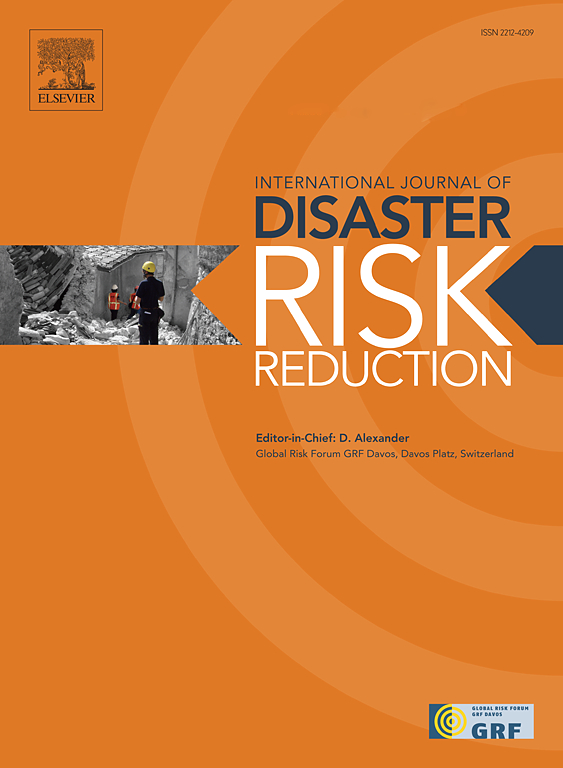评估城市火灾风险:基于情景和案例的集合学习法
IF 4.5
1区 地球科学
Q1 GEOSCIENCES, MULTIDISCIPLINARY
International journal of disaster risk reduction
Pub Date : 2024-11-01
DOI:10.1016/j.ijdrr.2024.104941
引用次数: 0
摘要
城市火灾对人们的生命和财产构成重大威胁,因此充分估计风险至关重要。现有的城市火灾评估方法缺乏适用性,因为它们没有考虑到各个场景的组成部分和以往的案例。因此,本研究提出了基于场景和案例的城市火灾风险评估方法(SCBUFRA),旨在实现更全面、更准确的城市火灾风险评估。首先,该技术利用火灾案例和情景数据,以及递归特征消除法,挑选出用于评估城市火灾风险的要素。其次,利用数据驱动的授权技术和稳定性分析来确定精确的火灾风险值,并正确量化城市各区域的火灾危险等级。接着,使用亲和传播(AP)技术对场景元素进行聚类。然后,通过改进 R2 的加权策略,利用集合学习创建风险预测模型。最后,使用 Shapley 加法解释来研究导致城市火灾的因素。研究结果表明,SCBUFRA 优于流行的机器学习方法,犯罪数量、总人口和房价是火灾预测的最重要变量,该研究适用于城市火灾风险管理和消防资源分配。本文章由计算机程序翻译,如有差异,请以英文原文为准。
Assessing urban fire risk: An ensemble learning approach based on scenarios and cases
Urban fires represent a significant hazard to people’s lives and property, which makes it critical to estimate the risk adequately. Existing urban fire evaluation methods lack applicability because they do not take into account individual scene components and previous cases. As a result, this study offers the scenario- and case-based urban fire risk assessment approach (SCBUFRA), which seeks to achieve a more thorough and accurate urban fire risk assessment. First, the technique uses fire case and scenario data, as well as the recursive feature elimination method, to pick the elements utilized to assess urban fire risk. Second, the data-driven empowerment technique and stability analysis are utilized to determine the precise fire risk value and correctly quantify the fire danger level in each part of the city. Next, the Affinity Propagation (AP) technique is used to cluster scene elements. Ensemble learning is then used to create a risk prediction model by refining the weighting strategy of . Finally, Shapley additive explanations are used to investigate the elements causing urban fires. The findings show that SCBUFRA outperforms popular machine learning methods, that the number of crimes, gross population, and house price are the most important variables for fire prediction, and that the research is applicable to urban fire risk management and firefighting resource allocation.
求助全文
通过发布文献求助,成功后即可免费获取论文全文。
去求助
来源期刊

International journal of disaster risk reduction
GEOSCIENCES, MULTIDISCIPLINARYMETEOROLOGY-METEOROLOGY & ATMOSPHERIC SCIENCES
CiteScore
8.70
自引率
18.00%
发文量
688
审稿时长
79 days
期刊介绍:
The International Journal of Disaster Risk Reduction (IJDRR) is the journal for researchers, policymakers and practitioners across diverse disciplines: earth sciences and their implications; environmental sciences; engineering; urban studies; geography; and the social sciences. IJDRR publishes fundamental and applied research, critical reviews, policy papers and case studies with a particular focus on multi-disciplinary research that aims to reduce the impact of natural, technological, social and intentional disasters. IJDRR stimulates exchange of ideas and knowledge transfer on disaster research, mitigation, adaptation, prevention and risk reduction at all geographical scales: local, national and international.
Key topics:-
-multifaceted disaster and cascading disasters
-the development of disaster risk reduction strategies and techniques
-discussion and development of effective warning and educational systems for risk management at all levels
-disasters associated with climate change
-vulnerability analysis and vulnerability trends
-emerging risks
-resilience against disasters.
The journal particularly encourages papers that approach risk from a multi-disciplinary perspective.
 求助内容:
求助内容: 应助结果提醒方式:
应助结果提醒方式:


